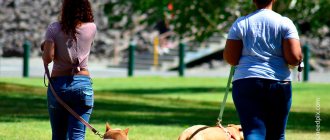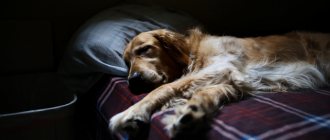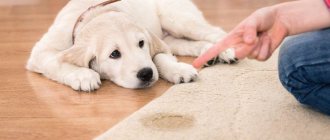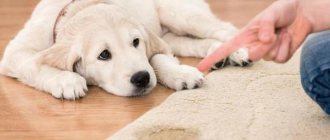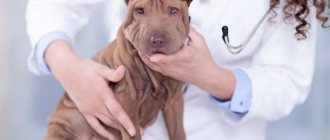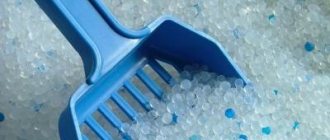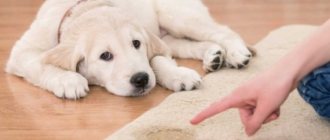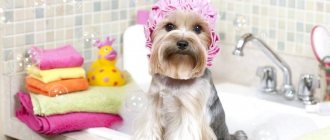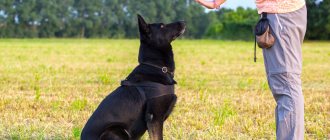The appearance of a dog in the house is a joyful event. However, after a while, some owners encounter a problem. The dog begins to relieve himself at home, and each family member runs the risk of getting into a puddle or pile. In order for attempts to retrain an animal to be productive, it is necessary to understand what caused this behavior. There are a number of tips to consider on how to stop your dog from peeing at home. In addition, it is worth learning how to react correctly to possible disobedience of your four-legged friend in the process of educational work.
Why does a dog pee in the wrong place?
If a small puppy pees in the wrong place, this is not considered a problem. Up to 4 months, the body of a young animal is not yet able to control natural processes. He has difficulty distinguishing between the urge to urinate or defecate. Re-education should begin when a dog over six months of age is unable to restrain its natural call.
An adult who pees in inappropriate places at home can experience serious health problems. In addition, there are several other common reasons why a large dog leaves puddles right on the floor.
Small decorative breeds often pee without leaving the apartment, if so intended by the owner. The only problem is that the dog does not always go to the designated place. It can be assumed that the main reason is an incorrectly selected device:
- the dog could grow out of the litter box;
- the animal does not like the material from which the “toilet” is made;
- the smell of detergent or new litter makes the dog disgusted;
- The quality of cleaning the tray leaves much to be desired.
In addition, small breeds are quite modest and shy individuals. They often cannot relieve themselves if the tray is in a visible place or in an aisle. Owners of ornamental animals who pass by to pee should consider and try to eliminate every possible one of the listed reasons.
Natural harmless causes
Experience and practice over many years of observation show that there are several natural reasons why a dog pees on itself.
- Severe emotion-based stress. Feeling joy or fear, a dog may involuntarily make a puddle.
- Mess. The dog is unclean by nature, has not received proper upbringing and simply does not know how to go to the toilet.
- Fear of other aggressive dogs.
There are other reasons, but these are the most common, and owners have nothing to worry about. This reaction is common for dogs; in this case, the animals are governed by instincts.
The instinctive desire to mark territory, for example, with urine, is very developed - males do it anywhere in the house, and females prefer it in the corners. To avoid such incidents, you need to work a little on the animal's behavior.
© shutterstock
How to stop a puppy from peeing
It takes a lot of time to teach a pet to walk in a small way to a place designated for this purpose. To avoid unpleasant moments, you should walk him more often. At home, you need to periodically bring the puppy to the diaper if restless behavior becomes noticeable.
Experienced breeders advise strictly observing the daily routine, and not postponing meals or walking even for the shortest period of time. Commands pronounced in a serious voice can help the dog restrain himself. The dog must begin to understand that soon it will be time for a walk, and there he can do all the necessary things.
Voiced commands such as: “Sit”, “Lie down”, “Come to me”, “Walk” and others will distract the dog from physiological needs. A stern human voice will help stop the dog from peeing with joy at the sight of its owner. By concentrating on their precise execution, the puppy can forget about the acute physiological need.
The method of teaching a small puppy to relieve itself outdoors is to follow some rules:
- You should start taking your puppy outside immediately after the end of quarantine. You need to go for a walk after sleeping and eating. You can finish the walk once all the necessary things have been done by the dog.
- At home, you need to lay out diapers or newspapers in those places where a puddle has already formed and the smell remains.
- When the need arises to wean your dog from peeing on diapers at home, you should start taking used bedding with you outside. The pet should be explained that now he will have to pee and poop on the ground. A familiar smell will help the dog overcome his fear of a new place.
To provoke urges on the street, it is recommended to take water for a walk and give the puppy something to drink. Physical activity promotes metabolism, so in combination with drinking, it will quickly affect the pet’s body. Diapers and newspapers are gradually removed from the house.
Writing in living quarters is beginning to be strictly suppressed. Stopping a puppy from peeing on the sofa, curtains, things and floor at home is much easier than dealing with an already matured individual.
Treatment
The first thing to do if your dog is peeing is to make a mental note of any possible changes to his diet or daily routine.
As mentioned above, sometimes a change in food or weather can cause him to drink more water and urinate more as a result.
If you can't think of any lifestyle changes that may have caused your dog to pee, consider the possible causes listed above. Try to look for other symptoms of dog illness that your dog may be exhibiting so you can report them to your veterinarian.
Also, if possible, try collecting a sample of your dog's urine so your veterinarian can do a urine test.
Weaning an adult dog
Adults have more reasons for peeing at home than puppies:
- Pathologies of internal organs. The main causes of incontinence are diseases of the genitourinary system, gastrointestinal tract, and helminthic infestations. Failures in the hormonal system can also provoke incorrect actions on the part of an adult. Before doing corrective work on a dog peeing anywhere, you need to check whether it is sick.
- Old age. The urinary system in older animals becomes increasingly weaker. Some organs begin to work intermittently. Therefore, urinary incontinence is a completely natural occurrence for an elderly pet. In such a situation, nothing will help. An old dog may start peeing on the carpet, on the owner's bed, on its own bed, and in other places. An aged animal will pee not only on the floor of the apartment, but also on its bed, furniture and even its owner. All that remains is to wait out these moments.
- Incorrect daily routine. If a pet cannot wait for a person to come home from work, and leaves a puddle on the threshold in the absence of its owners, it is worth checking the evenness of the intervals between walks. You should take your dog outside at least twice a day. In addition, it is necessary to take into account the duration of the interval between meals and walks. The dog may simply physically not be able to withstand long periods, so the daily schedule needs to be reconsidered. When going outside, the dog may not be able to restrain himself and pee along the way, for example, in the entrance of a house.
- Emotional shock, fear. Moving to a new place of residence, the appearance of a new pet or child in the family is always a surprise for a dog, most often an unpleasant one. A stressful situation undermines the animal’s mental balance; the dog may begin to pee at home. Also, an adult may become frightened if the owners swear loudly or even fight in his presence. Your four-legged friend may be frightened by gunshots or fireworks. You need to monitor the dog’s behavior: if loud bangs are always accompanied by puddles left by the dog, then the problem is fear. You need to calm your pet down and take care of his peace of mind.
- Pets are no strangers to the feeling of jealousy. If the dear owner begins to devote more time and attention to another resident of the house, the dog may begin to fight for dominance. The dog owner should try to evenly distribute his attention to all family members, not forgetting about his four-legged friend.
- Revenge. The dog may be stressed, but if it has identified the culprit of its troubles, it may begin to take revenge. On the part of the animal, “revenge” consists of attempts to re-educate the person. In the dog’s opinion, the best remedy is open disobedience to the owner, performing opposite actions. Most pets take revenge in their “trademark” way - leaving puddles and piles in the most unexpected places. Here you can advise the dog owner to reconsider the relationship with her as a whole.
- Lack of education. In young male dogs during the period of maturation, relieving themselves at home may be a sign of poor upbringing, an attempt to revise dominance in the family. In this situation, the reason is not difficult to see - the animal is acting out of spite, deliberately leaving puddles or marks immediately after a walk. Lack of upbringing can also be seen in specimens taken from the street or from a shelter. Lack of cleanliness also occurs in dogs that have lived outside for a long time - in an enclosure. Such pets are the most difficult to wean from writing at home, but long-term attempts will certainly be crowned with success.
In each of the indicated situations, there is only one piece of advice - the pet should not be beaten for mistakes, even if they were made out of spite. Owners should be patient and wipe the floor after the dog after each failure. If the result of re-educating the dog is obvious, then the animal should be encouraged (patting the head, speaking kind words, giving favorite treats).
The animal should be walked under human supervision. Otherwise, the owner risks never knowing whether his pet went to relieve himself or not. If the dog was unable to pee within the prescribed period, the walking time should be increased.
Other reasons
- Age characteristics . The dog often pees on itself due to its advanced age - the past years have left an imprint on the body. In particular, the smooth muscles responsible for urination become weak, and therefore the dog often wants to go to the toilet and sometimes cannot wait to go outside. But there are special medications that can minimize such health consequences. Unfortunately, it is impossible to eliminate this problem, but a number of special medications have been developed specifically to solve such problems that can be given to your pet.
- In heat . Estrus, especially in young bitches who do not yet know the dog, is one of the reasons why a dog pees on itself. The dog experiences constant pain and tries to eliminate it, goes to the toilet, where it ends up. The problem can be solved simply - you need to take the animal for a walk as often as possible. At night, of course, you will have to do this, but here the choice is between cleanliness in the house and the desire to sleep.
- Injuries . Urination may become more frequent due to injury, such as an injury to the dog's spine. The likelihood of such damage is greater in breeds with long, elongated spines.
- Compression of nerve endings . This phenomenon often occurs during or after childbirth. Dog potties are so, very gentle. The bitch usually refuses children and leaves puppies. A disease of this kind can only be diagnosed with a complete examination of the pet. The veterinarian uses several treatment methods, and if they do not help, surgery is performed.
Chemicals
The assortment of pet stores offers a number of products that help your dog learn to pee anywhere:
- "Antigadin" is available in the form of a spray. The components of the composition give the dog's marks a repulsive odor. Areas where the dog has peed should be treated daily;
- “Best Friend” spray eliminates the pungent odor of urine. The orange aroma that remains at the site of application is unpleasant for the animal;
- The American drug “Nature's Miracle” eliminates the odors of animal urine. Leaves behind a sharp aroma of citrus or lavender. It completely discourages the dog from pooping past the toilet.
If it is not possible to purchase an industrial composition, you should try to retrain your pet to pee and poop in the wrong place using folk remedies.
Treating an Animal with Frequent Urination
Before starting treatment, the pet must be examined in order to identify the root cause of urinary incontinence.
Be sure to give urine and blood samples for analysis in order to identify the inflammatory process. Ultrasound diagnostics and x-rays are also performed, which will help detect a neoplasm or pathology in the structure of internal organs.
The method of treatment depends on the root cause of the disease or frequent urination:
- Inflammatory process (cystitis, urethritis, etc.). It may leak. In this case, the veterinarian prescribes a course of antibiotics (amoxiclav, etc.). Antispasmodics are used to relieve pain. A single dose of monural powder gives a good effect. Cyston and stop cystitis are also used to relieve inflammation and treat cystitis.
- Neoplasms in the urinary organs. If the dog is unable to control due to swelling, the veterinarian will perform an examination and schedule surgery to remove the abnormal tissue. She walks under herself. If the neoplasm is malignant, the dog is prescribed a course of chemotherapy.
- Consequences of sterilization (weakening of the sphincter). To treat this type of illness, the drug propalin is used. The dosage is calculated based on the weight of the pet. This drug can be given to the animal for life.
- Urolithiasis disease. This disease is treated with a veterinary diet, which dissolves sand and struvite. Large stones are removed through surgery. Among the medications prescribed are stop cystitis, healthy kidney phytoelites, and furosemide.
Antibiotic Lek (Sandoz) Amoxiclav
If an older dog is suffering, the animal should be given a longer walk. You can also put an absorbent disposable diaper on your pet.
In some cases, taking the drug propalin, which helps to increase the tone of the urethral sphincter, has a good effect.
Folk remedies
It is known that animals do not tolerate the smell of citrus. Orange or lemon peels should be placed in the places where the dog peed.
Another radical method is to use ground pepper. Having tried to sniff one of the places where a “crime” had already been committed, the dog will inhale an unpleasant substance. Please note that the irritant can damage the pet’s nasal mucous membranes.
The last method is to wash the areas where puddles form with strong chemicals containing bleach. The strong smell will overcome the ammonia tint, so the dog will not pee past the installed tray again.
Why does your pet urinate frequently?
Frequent urination indicates that an inflammatory process is occurring in the urinary organs.
The dog experiences discomfort or pain when trying to empty its bladder, often sits down, but cannot squeeze out more than a few drops.
This condition may be the result of normal hypothermia, urethritis or cystitis. Also, frequent urination indicates the development of urolithiasis, which may be accompanied by the appearance of blood in the urine.
For adequate treatment it is necessary to have an accurate diagnosis
Please contact your operator for the cost of services not listed in the price list.
| Veterinary services | Cost, rub. |
| Vaccination of animals, vaccinations | |
| Routine cat vaccination | 550 |
| Routine dog vaccination | 650 |
| Vaccination of dogs at home | 900 |
| Vaccinations for puppies | 600-1000 |
| Vaccinations for kittens | 500-900 |
| Vaccination against rabies in dogs | 1250 |
| Veterinarian at home for vaccination | 400 |
| Animal surgery (surgery for dogs, surgery for cats) | |
| Removal of papillomas | 500 |
| Removal of subcutaneous tumor | 600-1500 |
| Cat sterilization | 1900 |
| Sterilizing a cat at home | 2250 |
| Castration of cats | 1450 |
| Castration of cats at home | 1700 |
| Dog sterilization | 2700 |
| Dog castration | 2200 |
| Sterilization of cats laparoscopy | 2900 |
| Castration of a male dog | 2700 |
| Sterilization of dogs laparoscopy | 3200 |
| Tail fracture in a dog, treatment | 900 |
| Fractures in dogs | 1100 |
| Fracture/dislocation in a dog | 900 |
| Fracture/dislocation in a cat | 900 |
| Pinched toes in dogs | 1300 |
| Amputation of vestigial digits in dogs | 1150 |
| Animal therapy | |
| Treatment of wounds and surgical sutures | 250-350 |
| Removing stitches for a dog or cat | 200-350 |
| Injections for a cat | 300-400 |
| Injections for a dog | 400-500 |
| Probing the dog's esophagus | 1380 |
| Gastric lavage in a dog | 1550 |
| Euthanasia of animals | |
| Put the dog to sleep | 2400 |
| Putting a dog to sleep at home | 2600 |
| Put the cat to sleep | 1600 |
| Euthanasia of cats | 1600 |
| Euthanasia of a cat at home | 1800 |
| Animal cremation | |
| General pet cremation | 1500-2500 |
| Individual animal cremation | 3500 |
| Cremation of dogs (up to 10 kg) | 3000 |
| Cremation of dogs (from 10 to 20 kg) | 5000 |
| Cremation of a dog over 20 kg | negotiable |
| Cremation of cats | 1550 |
| Animal diseases and their treatment | |
| Inflammation of the ear in a dog, otitis media | 1150 |
| Toxoplasmosis in a dog | 1450 |
| Piroplasmosis in dogs treatment | 1850 |
| Dermatitis in a dog | 950 |
| Rhinitis in dogs treatment | 970 |
| Stomatitis in a dog | 970 |
| Treatment for styes in dogs | 980 |
| Urolithiasis in cats | 1850 |
| Heart failure in a cat/dog | 1600-1900 |
| Feline panleukopenia | 2140 |
| Toxoplasmosis | 950 |
| Distemper in a dog | 950 |
| Staphylococcus in a dog | 850 |
| Piroplasmosis in a dog/cat | 1800 |
| Ringworm in cats and dogs | 100-800 |
| Worms in a cat | 700-1200 |
| Veterinarian services | |
| Calling a veterinarian to your home | 400 |
| Vet visit at night | 600 |
| Veterinarian ophthalmologist reception in veterinary clinic | 1200 |
| Doctor ratologist reception in veterinary clinic | 1250 |
| Turtle doctor (herpetologist) | 1250 |
| Treatment of ferrets | 1050 |
| Treatment of rats | 1050 |
| Treatment of rodents | 1100 |
| Treatment of hamsters | 1100 |
| Reptile doctor | 1600 |
| Treatment of mice | 1100 |
| Animal grooming. grooming salon | |
| Calling a veterinarian-groomer to your home | 1200 |
| Dog grooming | 1300 |
| Cat grooming | 980 |
| Washing and drying dogs | 630 |
| Model dog haircut | 1560 |
| Hygienic cat grooming | 1050 |
| Removing tangles | 690 |
| Trimming cat's claws | 590 |
| Trimming dog's nails | 790 |
| Zoohotel | |
| Dog foster care | 380 |
| Hotel for cats | 270 |
| Hotel for dogs (for stays longer than 7 days) | 350 |
| Dog foster care (vip conditions) | 800 |
| Overexposure of large breed dogs | from 800 |
| Tests for animals | |
| Adenovirus/canine hepatitis | 600 |
| Blood test for infections (PCR) | 750-1900 |
| Canine herpes virus | 630 |
| Borelliosis Lyme disease | 650 |
| Feline calicivirus | 630 |
| Brucellosis | 650 |
| Epstein-Barr virus | 650 |
| Leptospirosis | 650 |
| Mycoplasmosis | 650 |
| Canine piroplasmosis | 660 |
| Panleukopenia | 650 |
| Parvovirus enteritis | 650 |
| Carnivore plague | 550 |
| Diagnostics for animals | |
| Radiography 1 projection | 1000 |
| X-ray 2 projections | 1700 |
| Echokg for animals | 2400 |
| ECG (electrocardiography) | 3000 |
| Ultrasound examination of all organs | 2500 |
| Ultrasound for cats (one organ) | 1450 |
| Ultrasound for dogs (one organ) | 1600 |
| Dentistry for animals | |
| Removing tartar from a cat | 2160 |
| Removing tartar from a dog | 2380 |
| Cat teeth extraction | 480 |
| Dog tooth extraction | 690 |
| Assistance in childbirth for animals | |
| Conservative obstetrics | 1000 |
| Cat birth assistance in adoption | 1200 |
| Examination of a cat before birth | 900 |
| Childbirth in a cat, help with complications | 1500 |
| Childbirth in a dog, help from a veterinarian | 1920 |
| Caesarean section for a cat | 3000 |
| Caesarean section for a dog | 5000 |
Urinary incontinence
Common symptoms are sudden uncontrollable urges, involuntary urination, and constant leakage of urine in small portions. There are small wet spots on the bedding after sleep, urine is released from sudden movements. If we are not talking about a congenital pathology, older, larger dogs are more likely to suffer from incontinence. Provoking factors are excess weight, low mobility, frequent childbirth. In chronic cases, the risk of urinary tract infections increases.
| CAUSE | SYMPTOMS | TREATMENT |
| Ectopia is a structural anomaly in which the ureter protrudes into the vagina (females) or urethra (males). | Leaks in the first days after birth. The puppy smells bad. The genitals are inflamed, licked by the bitch. | The ureter is surgically removed into the bladder. |
| Sphincteric insufficiency after sterilization. Large females that are spayed after puberty are susceptible. | Involuntary bowel movements, usually in the morning and at night. Sometimes the dog constantly leaks drop by drop. | Long-term hormonal therapy aimed at maintaining sphincter function. Surgical correction is possible. |
| Complicated course of infectious diseases of the genitourinary tract. | Due to decreased receptor sensitivity, it is impossible to control urges. Urine flows randomly, first drop by drop, then in larger portions. | Elimination of infection and the cause of the disease, strengthening the immune system. |
| Injury - blow to the stomach, fall from a height. The injury initially causes delay, but the long-term consequence may be incontinence. | Due to decreased innervation of the bladder and/or sphincter, the dog ceases to feel the urge and control the process. Partial or complete incontinence may occur. | Treatment is surgical coupled with long-term therapy. The forecast is cautious. |
| Problems with urethral closure - decreased sphincter function due to congenital pathology, infection, obesity, and age-related changes. | Urine flows out even at rest, in small portions. The dog constantly licks himself, smells unpleasant, and his genitals are inflamed. | Long-term therapy, often including hormonal drugs. |
Incontinence is usually not as dangerous as urinary retention, but it does cause a lot of inconvenience for owners. It is important to remember that you should not scold your pet - stress will only make the situation worse. To minimize the consequences, you need to use diapers, remove carpets during treatment and walk longer.
You should not try to reduce the amount of drinking water in your diet - concentrated urine more irritates the walls of the organ, which leads to increased urination. It is important to follow the prescribed diet, avoid hypothermia, and exclude sweets and dairy products.
First days at home
As soon as the puppy appears in the house, you should cover everything with diapers. The baby does not yet understand that he can relieve himself only in certain places. Therefore, be prepared that the dog will start peeing wherever he wants. If you have carpets, remove them and cover the parquet with linoleum. You can teach a dog to pee on a diaper only calmly and without screaming. Otherwise, the puppy will not understand what you want. Another extreme variant of the manifestation of negative emotions from the owner’s screams is behavior disorder. It can be expressed not only in erratic trips to the toilet, but also affect subsequent education.
At first, you need to try to devote time to forming a trusting relationship. How kindly you treat your dog will influence the development of its character. But to cultivate discipline, one must not forget about the rigor and confidence of the voice.
Never punish a dog unless you catch it doing something dirty. Of course, you can clean it up in front of her, telling her that doing so is bad. You can only punish if you see the dog peeing on something other than a diaper. But in the first days of being at home, it is better to avoid such moralizing.
Raising and physiology of puppies
Trying to solve the problem, owners resort to extremes, get offended by the pet, consider it stupid... in most “dead-end problems” it is the dog’s owner who is wrong - this is an axiom. The first thing to do is stop getting angry, even if your pet has already peed on the carpet or bed - start with a clean slate! Approach the issue from a physiological point of view and everything will work out - 100% guarantee.
Important! The methods below do not involve physical punishment, but are based on the methodology of working with mentally healthy dogs!
How to arrange diapers around the house?
Any dog will not urinate where it sleeps. You should also avoid inconvenient places and corners of the apartment far from the sleeping bed. The diapers should be laid out in the room where the pet is. First you will have to cover almost the entire floor. The dog will then choose a few favorite places to urinate. The goal of the first stage of training is to consolidate the “diaper-toilet” relationship. And it doesn’t matter if the puppy misses a little. It’s better to lay another one and praise for choosing the right place. You can scold, but you need to do it carefully and think about how not to harm the dog’s psyche. Everyone can learn to pee on a diaper. The main thing is to understand that it takes time to develop a skill.
If you don’t want to clean the entire apartment, you can use a metal fence that zones the space of the room. This will make it easier for you to accustom your puppy to hygiene and order, since after a while the space for going to the toilet will decrease.
